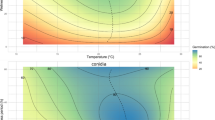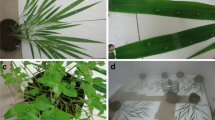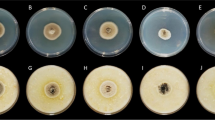Abstract
The effect of extended periods at low temperatures on spore germination, survival and appressorial formation in Colletotrichum acutatum and C. gloeosporioides, and on pre-formed appressoria of C. gloeosporioides, was studied on water agar on glass slides on a temperature gradient plate. C. acutatum was more tolerant of low temperatures than was C. gloeosporioides. The addition of peptone to simulate endogenous nutrients on the avocado fruit surface affected spore germination and survival only slightly, and the effect was not statistically significant. These trends in vitro were also apparent in isolations from fruit rots. Infections by C. acutatum were not reduced by storage at 5.5°C before ripening. Incidence of infections caused by C. gloeosporioides was significantly fewer in fruit coolstored at 5.5°C for 30 days prior to ripening at 20°C than in fruit stored at 20°C. In the two lines of fruit studied, coolstorage reduced body rots in one line but not the other. The rots on the line of fruit not affected by coolstorage were mainly caused by C. acutatum. These results suggest that in coolstored fruit, the reduction in incidence of rots caused by C. gloeosporioides, but not of rots caused by the closely related fungus C. acutatum, was due to the greater sensitivity of spores of C. gloeosporioides to cold temperatures. Survival of pre-formed appressoria of C. gloeosporioides was not affected by temperatures used for coolstorage of avocados.
Similar content being viewed by others
References
Bailey JA, O’Connell RJ, Pring RJ, Nash C (1992) Infection strategies of Colletotrichum species. In ‘Colletotrichum: biology, pathology and control’. (Eds JA Bailey, MJ Jeger) pp. 88–120. (British Society of Plant Pathology, CAB International; Wallingford, Oxon, UK)
Binyamini N, Schiffmann-Nadel M (1972) Latent infection in avocado fruit due to Colletotrichum gloeosporioides. Phytopathology 62, 592–594.
Brown GE (1975) Factors affecting post-harvest development of Colletotrichum gloeosporioides in citrus fruits. Phytopathology 67, 315–320.
Chan HT, Nishijima KA, Taniguchi MH, Linse ES (1996) Thermal death kinetics of some common postharvest pathogens of papaya. HortScience 31, 998–1002.
Coates LM, Irwin JAG, Muirhead IF (1993a) Theuse of a benomyl-resistant mutant to demonstrate latency of Colletotrichum gloeosporioides in avocado fruit. Australian Journal of Agricultural Research 44, 763–772.
Coates LM, Muirhead IF, Irwin JAG, Gowanlock DH (1993b) Initial infection processes by Colletotrichum gloeosporioides on avocado fruit. Mycological Research 97, 1363–1370.
Denner FDN, Kotzé JM Putterill JF (1986) The effect of temperature on spore germination, growth and appressorium formation of Colletotrichum gloeosporioides and Dothiorella aromatica. South African Avocado Growers’ Association Yearbook 9, 19–22.
Dillard HR (1988) Influence of temperature, pH, osmotic potential, and fungicide sensitivity on germination of conidia and growth from sclerotia of Colletotrichum coccodes in vitro. Phytopathology 78, 1357–1361.
Estrada AB, Dodd JC, Jeffries P (2000) Effect of humidity and temperatureonconidialgerminationandappressorium development of two Philippine isolates of the mango anthracnose pathogen Colletotrichum gloeosporioides. Plant Pathology 49, 608–618.
Everett KR, Hallett IC (1997) Is Colletotrichum acutatum an important pathogen of ‘Hass’ avocado in New Zealand? In ‘Proceedings of the 11th Biennial Australasian Plant Pathology Society Conference’. Perth. Abstract No. 306.
Fernando THPS, Jayasinghe CK, Wijesundera RLC (2000) Factors affecting spore production, germinationand viability of Colletotrichum acutatum isolatesfrom Hevea brasiliensis. Mycological Research 104, 681–685.
Flaishman MA, Kolattukudy PE (1994) Timing of fungal invasion using host’s ripening hormone as a signal. Proceedings of the National Academy of Sciences USA 91, 6579–6583.
Hartiii WFT (1991) Post-harvest diseases of avocado fruits in New Zealand. New Zealand Journal of Crop and Horticultural Science 19, 297–304.
Hopkirk G, White A, Beever DJ, Forbes SK (1994) Influence of postharvest temperatures and the rate of fruit ripening on internal postharvest rots and disorders of New Zealand ‘Hass’ avocado fruit. New Zealand Journal of Crop and Horticultural Science 22, 305–311.
Pennycook SR (1989) ‘Plant diseases recorded in New Zealand.’ (Plant Diseases Division, DSIR; Auckland, New Zealand)
Peterson RA (1978) Susceptibility of Fuerte avocado fruit at various stages of growth to infection by anthracnose and stem-end rot fungi. Australian Journal of Experimental Agriculture and Animal Husbandry 18, 158–160.
Prusky D, Keen NT, Sims JJ, Midland SL (1982) Possible involvement of an antifungal diene in the latencyof Colletotrichum gloeosporioides on unripe avocado fruits. Phytopathology 72, 1578–1582.
Prusky D, Kobiler I, Fishman Y, Sims JJ, Midland SL, Keen NT (1991) Identification of an antifungal compound in unripe avocado fruits and its possibleinvolvement in the quiescent infections of Colletotrichum gloeosporioides. Journal of Phytopathology 132, 319–327.
Simmonds JH (1965) A study of the species of Colletotrichum causing ripe fruit rots in Queensland. Queensland Journal of Agricultural and Animal Sciences 22, 437–459.
Author information
Authors and Affiliations
Corresponding author
Rights and permissions
About this article
Cite this article
Everett, K.R. The effect of low temperatures on Colletotrichum acutatum and Colletotrichum gloeosporioides causing body rots of avocados in New Zealand. Australasian Plant Pathology 32, 441–448 (2003). https://doi.org/10.1071/AP03050
Received:
Accepted:
Issue Date:
DOI: https://doi.org/10.1071/AP03050




